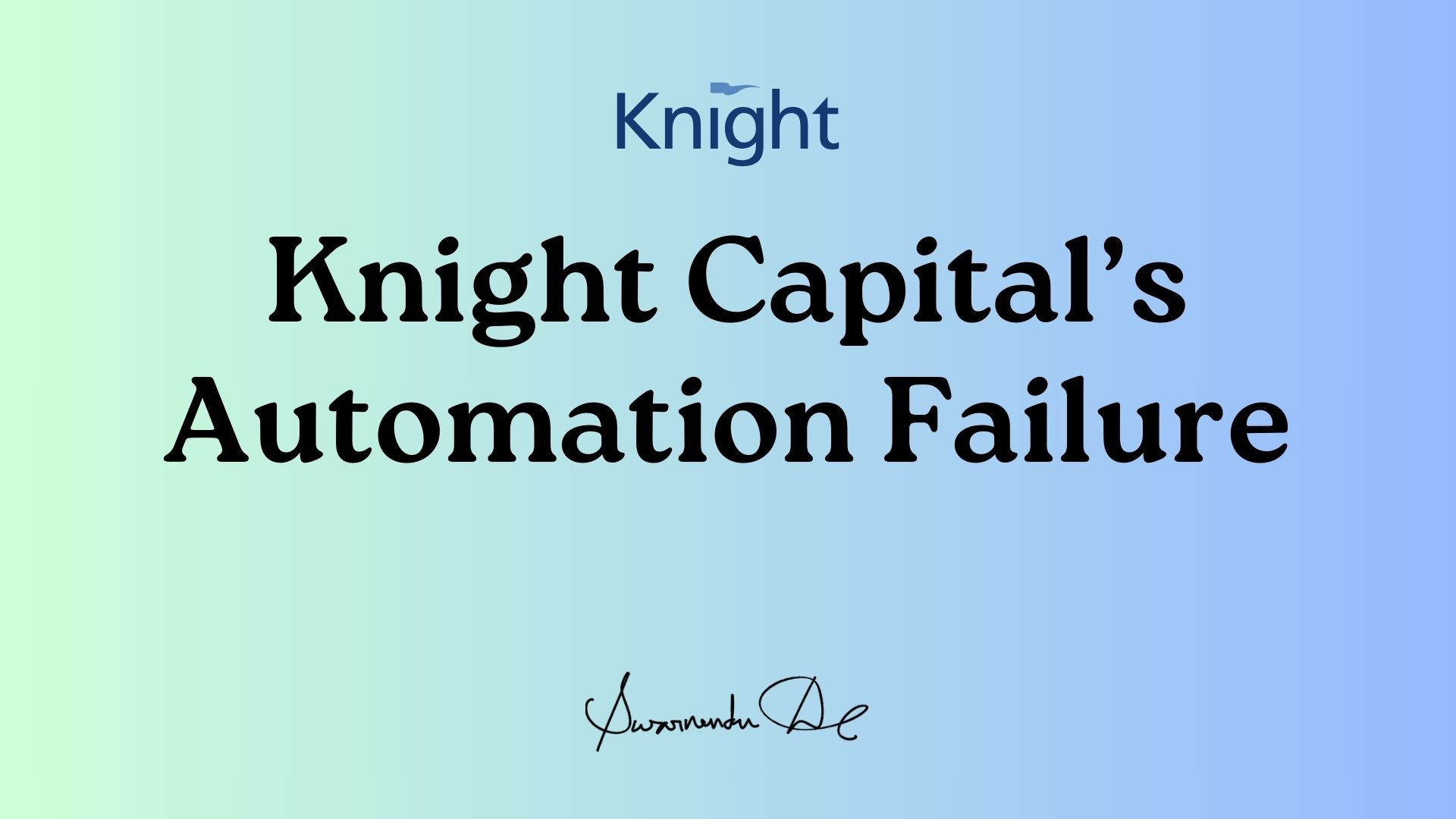Let me tell you about one of the most expensive 45-minute periods in financial history – a story that perfectly illustrates how sophisticated automation can catastrophically fail when it encounters real-world complexity.
On August 1, 2012, at exactly 9:30 AM EST, Knight Capital Group—one of Wall Street’s leading trading houses—deployed what should have been a routine software update to participate in the NYSE’s new Retail Liquidity Program (RLP). Within 45 minutes, their automated trading system had executed over 4 million trades, bought $7 billion worth of stocks they didn’t intend to purchase, and nearly destroyed a company that took 17 years to build.
The Automation That Worked Too Well
Knight’s SMARS (Smart Market Access Routing System) was a marvel of financial automation. It could execute thousands of orders per second, comparing prices across dozens of trading venues within fractions of a second. This wasn’t some simple RPA bot—this was sophisticated, high-frequency trading automation that handled billions of dollars daily.
The system worked on what seemed like bulletproof logic: receive “parent” orders from upstream systems, break them into smaller “child” orders, send them to various exchanges for execution, track confirmations, and stop when the original order was filled. Beautiful in its simplicity, devastatingly effective in practice.
But here’s where the automation wall manifested in the most expensive way possible.
The Fatal Flaw: When Logic Meets Reality
The new RLP code was supposed to replace some unused legacy code called “Power Peg”—a test algorithm from 2003 that was specifically designed to buy high and sell low to test other trading systems. Knight had stopped using Power Peg nearly a decade earlier, but the code remained dormant in their system.
When Knight’s engineer manually deployed the new RLP code to eight servers, he made a critical error: he forgot to deploy it to one server. That eighth server still had the old configuration, which meant that when RLP orders arrived, they triggered the dormant Power Peg code instead.
Here’s the terrifying part: Power Peg was designed to buy high and sell low continuously, but the code that was supposed to report back completed transactions had been broken during a 2005 system refactoring. The algorithm never received confirmation that orders were filled, so it kept sending more orders—thousands per second.
The Human Response That Made Everything Worse
At 9:34 AM, NYSE analysts noticed trading volumes were double normal levels and traced it back to Knight. By then, Knight’s system had already started haemorrhaging money, but this is where human decision-making under pressure collided with automated complexity.
Knight’s IT team, lacking documented incident response procedures, spent 20 critical minutes trying to diagnose the problem. When they concluded the issue was with the new code, they made what seemed like the logical decision: revert all servers to the “old” working version.
This was catastrophic. They installed the same defective Power Peg code on all eight servers. What had been contained to one-eighth of their trading capacity now consumed their entire system. For the next 24 minutes, all eight servers bought high and sold low across 154 stocks without any throttling mechanism.
The Numbers That Tell the Story
In just 45 minutes, Knight Capital’s automation:
- Executed 4,026,087 trades across 154 different stocks
- Traded 397,245,000 shares (more than many stocks see in entire days)
- Accumulated $3.5 billion in unwanted long positions
- Accumulated $3.15 billion in unwanted short positions
- Generated trading volume representing 20-50% of total market activity in affected stocks
- Caused price movements of 5-10% in 75 different securities
The final damage: $440 million in losses—nearly the company’s entire market capitalization at the time.
Why This Wasn’t Just a “Glitch”
What makes the Knight Capital disaster so instructive isn’t the technical failure—it’s how it reveals the fundamental limitations of traditional automation paradigms when confronted with edge cases and human error under pressure.
Knight had sophisticated technology, experienced teams, and robust systems. But their automation operated on deterministic logic that couldn’t adapt when circumstances deviated from programmed parameters. When the dormant Power Peg code activated, it followed its programming perfectly—it just wasn’t the right programming for the situation.
The human operators, facing an unprecedented crisis with no documented procedures, made rational decisions based on incomplete information. Their choice to “roll back” seemed logical, but the system’s complexity meant that logic led to disaster.
The Lessons for the Agentic Era
Knight Capital’s collapse illustrates exactly why the automation industry is shifting toward agentic approaches:
Rigid Logic vs. Adaptive Reasoning: Traditional automation follows predetermined paths. When Knight’s engineers decided to revert to the “old” code, their system couldn’t reason about whether this was actually safe—it just executed instructions.
Lack of Contextual Awareness: The Power Peg algorithm had no understanding of market conditions, risk limits, or business context. It was designed to move prices for testing, and that’s exactly what it did—regardless of the catastrophic consequences.
Human-System Coordination Failures: Under pressure, humans and systems worked at cross-purposes. Modern agentic systems are designed to collaborate with human operators, providing context and alternative scenarios rather than blind execution.
No Learning or Adaptation: Every one of those 4 million trades should have been a signal that something was wrong, but the system had no mechanism to learn from feedback or adapt its behaviour.
The irony is striking: Knight Capital was brought down not by market volatility or competitive pressure, but by an automation system that worked exactly as programmed. It followed its instructions with machine-like precision, even when those instructions were catastrophically wrong.
This is the automation wall in its purest form—the point where rigid, rule-based systems encounter complexity they cannot handle and human judgment cannot effectively intervene. Knight’s $440 million lesson became Silicon Valley’s blueprint for why the future of business automation lies not in smarter rules, but in systems that can think, adapt, and collaborate when the unexpected inevitably occurs.
The company was eventually acquired by Getco LLC for $1.4 billion, a shadow of its former value—a 17-year legacy destroyed in less than an hour by automation that couldn’t recognize when it was wrong.






